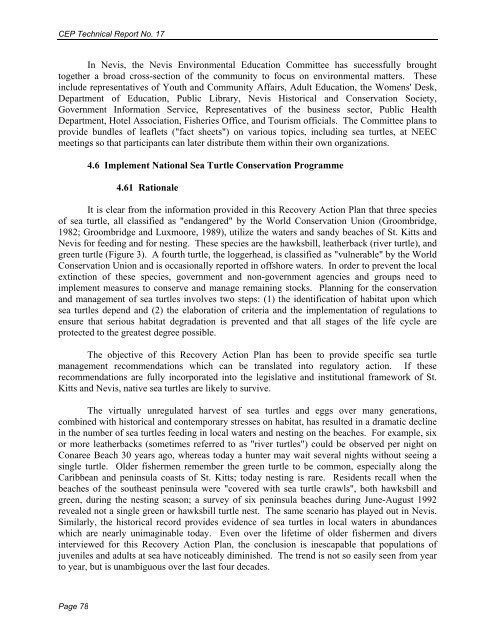Sea Turtle Recovery Action Plan for St. Kitts and Nevis - WIDECAST
Sea Turtle Recovery Action Plan for St. Kitts and Nevis - WIDECAST
Sea Turtle Recovery Action Plan for St. Kitts and Nevis - WIDECAST
Create successful ePaper yourself
Turn your PDF publications into a flip-book with our unique Google optimized e-Paper software.
CEP Technical Report No. 17<br />
In <strong>Nevis</strong>, the <strong>Nevis</strong> Environmental Education Committee has successfully brought<br />
together a broad cross-section of the community to focus on environmental matters. These<br />
include representatives of Youth <strong>and</strong> Community Affairs, Adult Education, the Womens' Desk,<br />
Department of Education, Public Library, <strong>Nevis</strong> Historical <strong>and</strong> Conservation Society,<br />
Government In<strong>for</strong>mation Service, Representatives of the business sector, Public Health<br />
Department, Hotel Association, Fisheries Office, <strong>and</strong> Tourism officials. The Committee plans to<br />
provide bundles of leaflets ("fact sheets") on various topics, including sea turtles, at NEEC<br />
meetings so that participants can later distribute them within their own organizations.<br />
4.6 Implement National <strong>Sea</strong> <strong>Turtle</strong> Conservation Programme<br />
4.61 Rationale<br />
It is clear from the in<strong>for</strong>mation provided in this <strong>Recovery</strong> <strong>Action</strong> <strong>Plan</strong> that three species<br />
of sea turtle, all classified as "endangered" by the World Conservation Union (Groombridge,<br />
1982; Groombridge <strong>and</strong> Luxmoore, 1989), utilize the waters <strong>and</strong> s<strong>and</strong>y beaches of <strong>St</strong>. <strong>Kitts</strong> <strong>and</strong><br />
<strong>Nevis</strong> <strong>for</strong> feeding <strong>and</strong> <strong>for</strong> nesting. These species are the hawksbill, leatherback (river turtle), <strong>and</strong><br />
green turtle (Figure 3). A fourth turtle, the loggerhead, is classified as "vulnerable" by the World<br />
Conservation Union <strong>and</strong> is occasionally reported in offshore waters. In order to prevent the local<br />
extinction of these species, government <strong>and</strong> non-government agencies <strong>and</strong> groups need to<br />
implement measures to conserve <strong>and</strong> manage remaining stocks. <strong>Plan</strong>ning <strong>for</strong> the conservation<br />
<strong>and</strong> management of sea turtles involves two steps: (1) the identification of habitat upon which<br />
sea turtles depend <strong>and</strong> (2) the elaboration of criteria <strong>and</strong> the implementation of regulations to<br />
ensure that serious habitat degradation is prevented <strong>and</strong> that all stages of the life cycle are<br />
protected to the greatest degree possible.<br />
The objective of this <strong>Recovery</strong> <strong>Action</strong> <strong>Plan</strong> has been to provide specific sea turtle<br />
management recommendations which can be translated into regulatory action. If these<br />
recommendations are fully incorporated into the legislative <strong>and</strong> institutional framework of <strong>St</strong>.<br />
<strong>Kitts</strong> <strong>and</strong> <strong>Nevis</strong>, native sea turtles are likely to survive.<br />
The virtually unregulated harvest of sea turtles <strong>and</strong> eggs over many generations,<br />
combined with historical <strong>and</strong> contemporary stresses on habitat, has resulted in a dramatic decline<br />
in the number of sea turtles feeding in local waters <strong>and</strong> nesting on the beaches. For example, six<br />
or more leatherbacks (sometimes referred to as "river turtles") could be observed per night on<br />
Conaree Beach 30 years ago, whereas today a hunter may wait several nights without seeing a<br />
single turtle. Older fishermen remember the green turtle to be common, especially along the<br />
Caribbean <strong>and</strong> peninsula coasts of <strong>St</strong>. <strong>Kitts</strong>; today nesting is rare. Residents recall when the<br />
beaches of the southeast peninsula were "covered with sea turtle crawls", both hawksbill <strong>and</strong><br />
green, during the nesting season; a survey of six peninsula beaches during June-August 1992<br />
revealed not a single green or hawksbill turtle nest. The same scenario has played out in <strong>Nevis</strong>.<br />
Similarly, the historical record provides evidence of sea turtles in local waters in abundances<br />
which are nearly unimaginable today. Even over the lifetime of older fishermen <strong>and</strong> divers<br />
interviewed <strong>for</strong> this <strong>Recovery</strong> <strong>Action</strong> <strong>Plan</strong>, the conclusion is inescapable that populations of<br />
juveniles <strong>and</strong> adults at sea have noticeably diminished. The trend is not so easily seen from year<br />
to year, but is unambiguous over the last four decades.<br />
Page 78
















